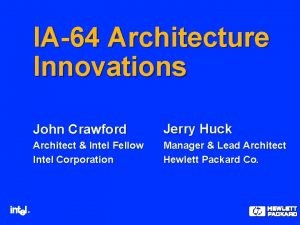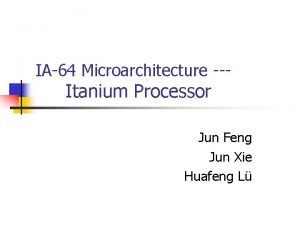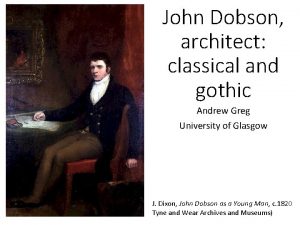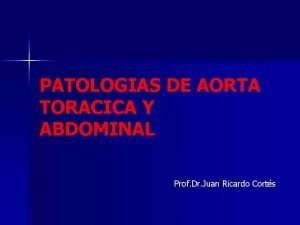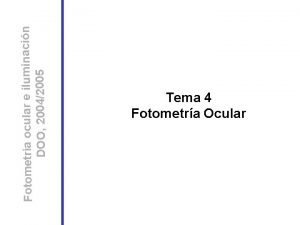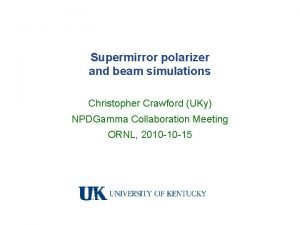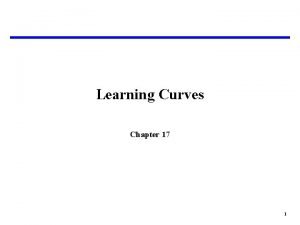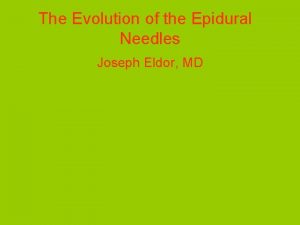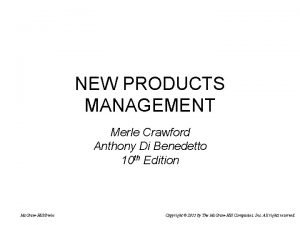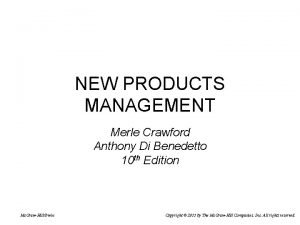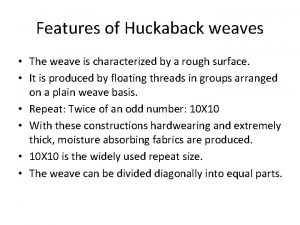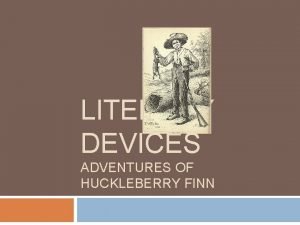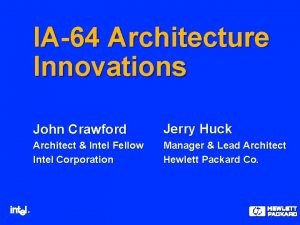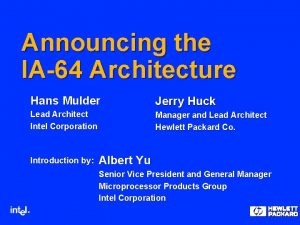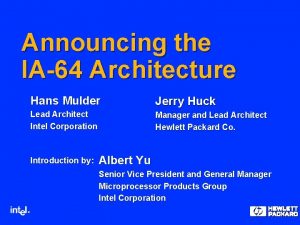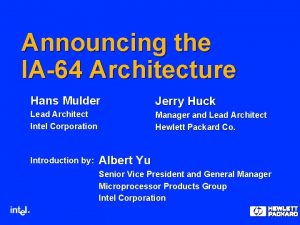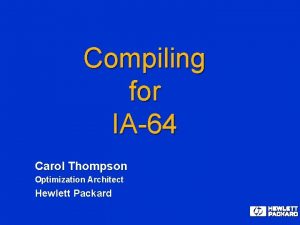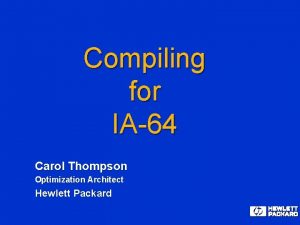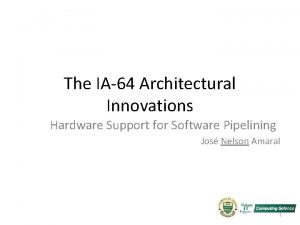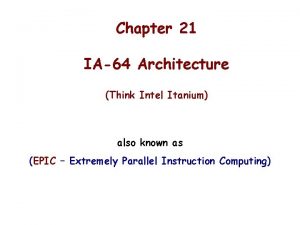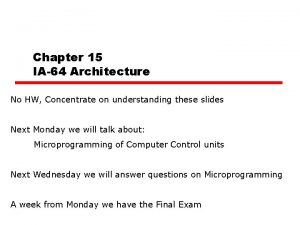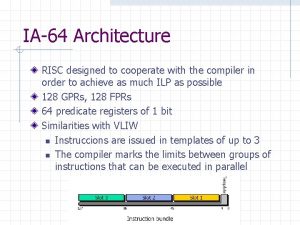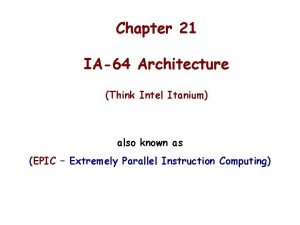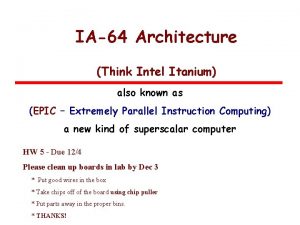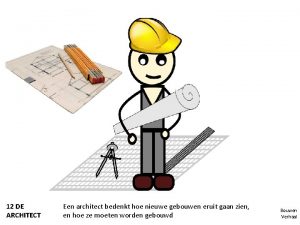IA64 Architecture Innovations John Crawford Jerry Huck Architect








![Eight Queens Example if ((b[j] == true) && (a[i+j] == true) && (c[i-j+7] == Eight Queens Example if ((b[j] == true) && (a[i+j] == true) && (c[i-j+7] ==](https://slidetodoc.com/presentation_image/2a292ff60722e9c0b84f9b3a834745a0/image-9.jpg)
![Eight Queens Example if ((b[j] == true) && (a[i+j] == true) && (c[i-j+7] == Eight Queens Example if ((b[j] == true) && (a[i+j] == true) && (c[i-j+7] ==](https://slidetodoc.com/presentation_image/2a292ff60722e9c0b84f9b3a834745a0/image-10.jpg)
![Eight Queens Example if ((b[j] == true) && (a[i+j] == true) && (c[i-j+7] == Eight Queens Example if ((b[j] == true) && (a[i+j] == true) && (c[i-j+7] ==](https://slidetodoc.com/presentation_image/2a292ff60722e9c0b84f9b3a834745a0/image-11.jpg)












































- Slides: 55

IA-64 Architecture Innovations ® John Crawford Jerry Huck Architect & Intel Fellow Intel Corporation Manager & Lead Architect Hewlett Packard Co.

Agenda l Architecture Principles l Predication & Speculation l Branch Architecture l Software Pipelining ®

Traditional Architectures: Limited Parallelism Original Source Code Compiler Sequential Machine Hardware Code parallelized code multiple functional units Execution Units Available Used Inefficiently ® . . . Today’s Processors often 60% Idle . . .

IA-64 Architecture: Explicit Parallelism Parallel Machine Code Original Source Code Compiler IA-64 Compiler Views Wider Scope ® Hardware More efficient use of execution resources multiple functional units . . . Increases Parallel Execution . . .

IA-64 Principles l Explicitly parallel: – Instruction level parallelism (ILP) in machine code – Compiler schedules across a wider scope l Enhanced ILP : – Predication, Speculation, Software pipelining, . . . l Fully compatible: – Across all IA-64 family members – IA-32 in hardware and PA-RISC through instruction mapping – Inherently scalable l Massively resourced: – Many registers – Many functional units ®

Predication Traditional Architectures IA-64 cmp then else l p 1 p 2 Removes branches, converts to predicated execution – Executes multiple paths simultaneously l ® Increases performance by exposing parallelism and reducing critical path – Better utilization of wider machines – Reduces mispredicted branches

Predication Review l Two kinds of normal compares – Regular – Unconditional (nested IF’s) (p 1) p 3= (p 2) p 3= p 1, p 2, <-. . . (p 2) p 3, p 4 <-cmp. unc. . . (p 3). . . Regular: p 3 is set just once ® p 2&p 3 (p 3). . . p 2&p 4 (p 4). . . Unconditional: p 3 and p 4 are AND’ed with p 2 Opportunity for Even More Parallelism

Introducing Parallel Compares l Three new types of compares: – AND: both target predicates set FALSE if compare is false – OR: both target predicates set TRUE if compare is true – ANDOR: if true, sets one TRUE, sets other FALSE A A B B C D ® Reduces Critical Path
![Eight Queens Example if bj true aij true cij7 Eight Queens Example if ((b[j] == true) && (a[i+j] == true) && (c[i-j+7] ==](https://slidetodoc.com/presentation_image/2a292ff60722e9c0b84f9b3a834745a0/image-9.jpg)
Eight Queens Example if ((b[j] == true) && (a[i+j] == true) && (c[i-j+7] == true)) Unconditional Compares 1 2 4 5 6 7 ® R 1=&b[j] R 3=&a[i+j] R 5=&c[i-j+7] ld R 2=[R 1] ld. s R 4=[R 3] ld. s R 6=[R 5] P 1, P 2 <-cmp. unc(R 2==true) (p 1) chk. s R 4 (p 1) P 3, P 4 <-cmp. unc(R 4==true) (p 3) chk. s R 6 (p 3) P 5, P 6 <-cmp. unc(R 5==true) (P 5) br then else 8 queens control flow P 2 P 1 P 3 P 5 P 4 P 6 Then Else
![Eight Queens Example if bj true aij true cij7 Eight Queens Example if ((b[j] == true) && (a[i+j] == true) && (c[i-j+7] ==](https://slidetodoc.com/presentation_image/2a292ff60722e9c0b84f9b3a834745a0/image-10.jpg)
Eight Queens Example if ((b[j] == true) && (a[i+j] == true) && (c[i-j+7] == true)) Parallel Compares 1 2 4 5 ® R 1=&b[j] R 3=&a[i+j] R 5=&c[i-j+7] p 1 <- true ld R 2=[R 1] ld R 4=[R 3] ld R 6=[R 5] p 1, p 2 <- cmp. and(R 2==true) p 1, p 2 <- cmp. and(R 4==true) p 1, p 2 <- cmp. and(R 6==true) (p 1) br then else P 1 8 queens control flow P 2 P 1 P 4 P 3 P 6 P 5 Then Else
![Eight Queens Example if bj true aij true cij7 Eight Queens Example if ((b[j] == true) && (a[i+j] == true) && (c[i-j+7] ==](https://slidetodoc.com/presentation_image/2a292ff60722e9c0b84f9b3a834745a0/image-11.jpg)
Eight Queens Example if ((b[j] == true) && (a[i+j] == true) && (c[i-j+7] == true)) Parallel Compares 1 2 4 5 ® R 1=&b[j] R 3=&a[i+j] R 5=&c[i-j+7] p 1 <- true ld R 2=[R 1] ld R 4=[R 3] ld R 6=[R 5] p 1, p 2 <- cmp. and(R 2==true) p 1, p 2 <- cmp. and(R 4==true) p 1, p 2 <- cmp. and(R 6==true) (p 1) br then else 8 queens control flow P 2 P 1 P 4 P 3 P 1= true P 5 Then Reduced from 7 cycles to 5 P 1=False P 6 Else

Five Predicate Compare Types l (qp) p 1, p 2 <- cmp. relation – if(qp) {p 1 = relation; p 2 = !relation}; l (qp) p 1, p 2 <- cmp. relation. unc – p 1 = qp&relation; p 2 = qp&!relation; l (qp) p 1, p 2 <- cmp. relation. and – if(qp & (relation==FALSE)) { p 1=0; p 2=0; } l (qp) p 1, p 2 <- cmp. relation. or – if(qp & (relation==TRUE)) { p 1=1; p 2=1; } l (qp) p 1, p 2 <- cmp. relation. or. andcm – if(qp & (relation==TRUE)) { p 1=1; p 2=0; } ® Tbit (Test Bit) Also Sets Predicates

Predication Benefits l Reduces branches and mispredict penalties – 50% fewer branches and 37% faster code* l l Parallel compares further reduce critical paths Greatly improves code with hard to predict branches – Large server apps- capacity limited – Sorting, data mining- large database apps – Data compression l Traditional architectures’ “bolt-on” approach can’t efficiently approximate predication – Cmove: 39% more instructions, 23% slower performance* – Instructions must all be speculative ® * Source: S. Mahlke, 1995

Speculation Review Traditional Architectures instr 1 instr. . . 2 br Load use Barrier IA-64 ld. s instr 1 instr 2 br chk. s use Allows elevation of load, even above a branch l Memory latency is a major performance bottleneck in today’s systems ® – CPU to memory gap increasing

Hoisting Uses IA-64 ld. s instr 1 instr 2 br chk. s use l The uses of speculative data can also be executed speculatively – distinguishes speculation from simple prefetch ® Enables Further Parallelism

Introducing the Na. T (“Not a Thing”) IA-64 ld. s instr 1 instr 2 br chk. s use l Na. T ; Exception Detection Propagate Exception ; Exception Delivery is the GR’s 65 th bit that indicates: – whether or not an exception has occurred – branch to fixup code required l Na. T ® set during ld. s, checked by Chk. s

Propagation l All computation instructions propagate Na. Ts to reduce number of checks ld 8. s r 3 = (r 9) ld 8. s r 4 = (r 10) add r 6 = r 3, r 4 ld 8. s r 5 = (r 6) p 1, p 2 = cmp(. . . ) Allows single chk on result chk. s r 5 sub r 7 = r 5, r 2 Cmp propagates “false” when writing predicates l RISC architectures require more instructions for equivalent integrity l ® – e. g. , non faulting load

Exception Deferral: More Than Skin Deep l l Deferral allows the efficient delay of costly exceptions OS controlled deferral by hardware of: – Page faults – Protection violations – … l l Na. Ts enable deferral with recovery Efficiently support structured exception handling in C/C++ ld. s instr 1 instr 2 uses br Recovery code chk. s (Home Block) ld uses br home Complete Solution for Exception Management ®

Control Speculation Summary l All loads have a speculative form that sets the Na. T bit when deferring exceptions l Computational instructions propagate Na. Ts l OS controls deferral of faults but supported directly in HW - “no-fault speculation” – Minimizes overhead of data that is not used l Chk ® more effective than non-faulting load

Store Barrier Traditional Architectures instr 1 instr 2. . . Store(*) Barrier Load (*) use Traditional architectures limited by the Store Barrier ®

Introducing Data Speculation l Compiler can issue a load prior to a preceding, possibly-conflicting store Traditional Architectures instr 1 instr 2. . . st 8 Barrier ld 8 use ® IA-64 ld 8. a instr 1 instr 2 st 8 ld. c use Unique feature to IA-64

Data Speculation l Uses can be hoisted ld 8. a instr 1 instr 2 st 8 ld. c use ® ld 8. a instr 1 use instr 2 st 8 chk. a Synergy with control speculation yields greater performance Recovery code ld 8 uses br home

Advanced Load Address Table - ALAT l l ld. a inserts entries. Conflicting stores remove entries – Also: ld. c. clr, chk. a. clr, l Presence of entry indicates success – chk. a branches when no entry is found ld. a reg# =. . . chk. a reg# ® ? reg # Address reg #. . . Address st

Architectural Support for Data Speculation l Instructions – ld. a - advanced loads – ld. c - check loads – chk. a - advance load checks l Speculative Advanced loads - ld. sa - is an advanced load with deferral l ALAT - HW structure containing outstanding advanced loads ®

Speculation Benefits l Reduces impact of memory latency – Study demonstrates performance improvement of 79% when combined with predication* l Greatest improvement to code with many cache accesses – Large databases – Operating systems l Scheduling flexibility enables new levels of performance headroom ® * August, et. al, 1998

Agenda ü Architecture Principles ü Predication & Speculation l Branch Architecture l Software Pipelining ®

Branch Instruction 128 -bit bundle 41 -bits 127 QP Branch IP-Offset Instruction 1 0 Instruction 0 Template 21 -bits l Two basic branch formats – Relative: IP : = IP + Offset 21 – Indirect: IP : = BR[I] – 8 branch registers for efficient branch execution – Call/Return linking through branch registers l Loop branches with 64 -bit loopcount register (LC) – Enables perfect branch prediction of counted loops – Traditional architectures always mispredict last iteration – Incurs misprediction stall costing many cycles ®

Branch Predicates Conditional branches Unconditional branches (p 1) BR #label_A; (p 0) BR #label_A; P 1=true A P 1=false B “always true” A l Compiler directed static prediction augments dynamic prediction ® – Better predict highly correlated branches (always/never taken) – Frees space in H/W predictor – Can give hint for dynamic predictor

Compare & Branch in Same Cycle Queens Loop: Parallel Compares & Compare-branch 1 2 4 ® R 1=&b[j] R 3=&a[i+j] R 5=&c[i-j+7] p 1 <- true ld R 2=[R 1] ld R 4=[R 3] ld R 6=[R 5] p 1, p 2 <- cmp. and(R 2==true) p 1, p 2 <- cmp. and(R 4==true) p 1, p 2 <- cmp. and(R 6==true) (p 1) br then else From 5 Cycles Down to 4

Multi-way Branch w/o Speculation P 1 ld 8 r 6 = (ra) (p 1) br exit 1 P 2 ld 8 r 7 = (rb) (p 3) br exit 2 P 3 P 5 P 4 ld 8 r 8 = (rc) (p 5) br exit 3 Hoisting Loads IA-64 ld 8. s r 6 = (ra) ld 8. s r 7 = (rb) ld 8. s r 8 = (rc) chk r 6, rec 0 (p 1) br exit 1 chk r 6, rec 0 (p 2) chk r 7, rec 1 (p 4) chk r 8, rec 2 }{ (p 1) br exit 1 (p 3) br exit 2 (p 5) br exit 3 } Chk r 7, rec 1 (p 3) br exit 2 Chk r 8, rec 2 (p 5) br exit 3 P 6 3 branch cycles l ® 1 branch cycle Multiway branches: more than 1 branch in a single cycle l Allows n-way branching Supports Aggressive Speculation

Software Pipelining l Overlapping execution of different loop iterations vs. l ® More iterations in same amount of time

Software Pipelining l IA-64 features that make this possible – Full Predication – Special branch handling features – Register rotation: removes loop copy overhead – Predicate rotation: removes prologue & epilogue l Traditional architectures use loop unrolling – High overhead: extra code for loop body, prologue, and epilogue Especially Useful for Integer Code With Small Number of Loop Iterations ®

Basic Loop Example For (i=0; i<n; i++) { *b++ = *a++; } /* Mem. Copy */ // setup ra/rb/lc, . label loop { ld 8 r 35 = [ra], 8 }{ st 8 [rb], 8 = r 35 br. cloop #loop // check n!=0 } 3 ops l Simple ® Basic Copy Loop Execution (Cycles) ld 1 1 st 1 2 3 ld 2 st 2 4 5 ld 3 st 3 6 ld 4 7 st 4 8 br. cloop Non-overlapping iterations – 2 cycles per iteration – 3 operations in loop body

Loop Support: Unrolling Test for loop count 0, 1 ld 8 r 34 = [ra], 8 10 ops . label loop ld 8 r 35 = [ra], 8 st 8 [rb], 8 = r 34 br. cle #e-exit ld 8 r 34 = [ra], 8 st 8 [rb], 8 = r 35 br. cloop #loop st 8 [rb], 8 = r 34 br #thru. label e-exit st 8 [rb], 8 = r 35. label thru ® Unrolled Copy Loop Execution cycles 1 2 3 4 5 ld 1 ld 2 ld 3 ld 4 Prologue st 1 st 2 st 3 st 4 l Overlapped br. cle br. cloop br. cle iterations – 1 cycle per word – 1. 6 X performance improvement – 3. 3 X code expansion Incurs Code Expansion Penalties Main loop Epilogue

Software Register Renaming Traditional Architecture. . . ld 1 r 34 ® R 32 R 33 R 34 R 35. . .

Software Register Renaming Traditional Architecture. . . st 1 r 34 ld 2 r 35 ® R 32 R 33 R 34 R 35. . .

Software Register Renaming Traditional Architecture. . . ld 3 r 34 st 2 r 35 ® R 32 R 33 R 34 R 35. . .

Software Register Renaming Traditional Architecture. . . st 3 r 34 ld 4 r 35 ® R 32 R 33 R 34 R 35. . .

Software Register Renaming Traditional Architecture. . . st 4 r 35 ® R 32 R 33 R 34 R 35. . .

Introducing Rotating Registers l l GR 32 -127, FR 32 -127 can rotate Separate Rotating Register Base for each: GRs, FRs Loop branches decrement all register rotating bases (RRB) Instructions contain a “virtual” register number – RRB + virtual register number = physical register number. . ld 1 R 35 Palm Springs ® is Sunny 36: 35: Palm 34: 33: 32: . . . RRB=0

Introducing Rotating Registers l l GR 32 -127, FR 32 -127 can rotate Separate Rotating Register Base for each: GRs, FRs Loop branches decrement all register rotating bases (RRB) Instructions contain a “virtual” register number – RRB + virtual register number = physical register number. Palm st 1 R 35 ld 2 R 34 Palm Springs ® is Sunny . . IA-64. 36: 35: Palm 34: Springs 33: 32: . . . RRB=0

Introducing Rotating Registers l l GR 32 -127, FR 32 -127 can rotate Separate Rotating Register Base for each: GRs, FRs Loop branches decrement all register rotating bases (RRB) Instructions contain a “virtual” register number – RRB + virtual register number = physical register number. Palm Springs st 2 R 35 ld 3 R 34 Palm Springs ® is Sunny . . IA-64. 35: Palm 34: Springs 33: is 32: 127: . . . RRB=-1

Introducing Rotating Registers l l GR 32 -127, FR 32 -127 can rotate Separate Rotating Register Base for each: GRs, FRs Loop branches decrement all register rotating bases (RRB) Instructions contain a “virtual” register number – RRB + virtual register number = physical register number. Palm Springs is st 3 R 35 ld 4 R 34 Palm Springs ® is Sunny . . IA-64. 34: Springs 33: is 32: Sunny 127: 126: . . . RRB=-2

Introducing Rotating Registers l l GR 32 -127, FR 32 -127 can rotate Separate Rotating Register Base for each: GRs, FRs Loop branches decrement all register rotating bases (RRB) Instructions contain a “virtual” register number – RRB + virtual register number = physical register number. Palm Springs is Sunny st 4 R 35 Palm Springs ® is Sunny . . IA-64. 33: is 32: Sunny 127: 126: 125: . . . RRB=-3

Loop Support: Rotating Registers // setup ra/rb/lc/ec, check n > 2 { ld 8 r 35 = [ra], 8 }. label loop { r 34 = [ra], 8 5 ops ld 8 st 8 [rb] = r 35, 8 br. ctop #loop }{ st 8 [rb] = r 35, 8 } l Software Pipelined Copy Loop Execution cycles 1 2 3 4 5 ld 1 ld 2 ld 3 ld 4 Prologue st 1 st 2 st 3 st 4 br. ctop Main loop br. ctop Epilogue Modulo Scheduled Iterations – 1 cycle per word – 1. 6 X performance improvement – additional upside for higher latency conditions ® – 1. 7 X code expansion

Introducing Rotating Predicate Registers l l l PR 16 -63 can rotate, with separate Rotating Register Base Loop branches decrement all register rotating base (RRB) Instructions contain a “virtual” predicate register number – RRB + virtual register number = physical register number. LC=3 EC=2 ® . . IA-64. 18: 0 17: 0 16: 10 63: 0 62: 0. . . RRB=0 Code (p 16) ld 1 R 34 (p 17) st R 35 (p 16) ld R 34 Initialize (p 17) st R 35

Introducing Rotating Predicate Registers l l l LC=2 EC=2 ® PR 16 -63 can rotate, with separate Rotating Register Base Loop branches decrement all register rotating base (RRB) Instructions contain a “virtual” predicate register number – RRB + virtual register number = physical register number. . . IA-64. 17: 18: 0 17: 10 16: 10 63: 01 62: 0 61: . . . RRB=-1 Code (p 17) st R 35 (p 16) ld R 34 (p 16) ld 1 R 34 (p 16) ld 2 R 34 Branch 1 (p 17) st R 35 (p 17) st 1 R 35

Introducing Rotating Predicate Registers l l l LC=1 EC=2 ® PR 16 -63 can rotate, with separate Rotating Register Base Loop branches decrement all register rotating base (RRB) Instructions contain a “virtual” predicate register number – RRB + virtual register number = physical register number. . . IA-64. 16: 18: 10 17: 10 16: 63: 16: 10 63: 62: 63: 01 62: 61: 62: 0 61: 60: . . . RRB=-2 Code (p 17) st R 35 (p 16) ld R 34 (p 16) ld 1 R 34 (p 16) ld 2 R 34 (p 16) ld 3 R 34 Branch 2 (p 17) st R 35 (p 17) st 1 R 35 (p 17) st 2 R 35

Introducing Rotating Predicate Registers l l l LC=0 EC=2 ® PR 16 -63 can rotate, with separate Rotating Register Base Loop branches decrement all register rotating base (RRB) Instructions contain a “virtual” predicate register number – RRB + virtual register number = physical register number. . . IA-64. 63: 18: 10 17: 16: 17: 10 16: 63: 62: 16: 10 63: 62: 61: 63: 01 62: 61: 60: 62: 0 61: 60: 59: . . . RRB=-3 Code (p 17) st R 35 (p 16) ld R 34 (p 16) ld 1 R 34 (p 16) ld 2 R 34 (p 16) ld 3 R 34 (p 16) ld 4 R 34 Branch 3 (p 17) st R 35 (p 17) st 1 R 35 (p 17) st 2 R 35 (p 17) st 3 R 35

Introducing Rotating Predicate Registers l l l LC=0 EC=1 ® PR 16 -63 can rotate, with separate Rotating Register Base Loop branches decrement all register rotating base (RRB) Instructions contain a “virtual” predicate register number – RRB + virtual register number = physical register number. . . IA-64. 62: 18: 10 17: 16: 63: 17: 10 16: 63: 62: 61: 16: 01 63: 62: 61: 60: 63: 01 62: 61: 60: 59: 62: 0 61: 60: 59: 58: . . . RRB=-4 Code (p 17) st R 35 (p 16) ld ld R 34 (p 16) ld 1 R 34 (p 16) ld 2 R 34 (p 16) ld 3 R 34 (p 16) ld 4 R 34 (p 16) ld R 34 Branch 4 (p 17) st R 35 (p 17) st 1 R 35 (p 17) st 2 R 35 (p 17) st 3 R 35

Introducing Rotating Predicate Registers l l l LC=0 EC=0 ® PR 16 -63 can rotate, with separate Rotating Register Base Loop branches decrement all register rotating base (RRB) Instructions contain a “virtual” predicate register number – RRB + virtual register number = physical register number. . . IA-64. 61: 18: 10 17: 16: 63: 62: 17: 01 16: 63: 62: 61: 60: 16: 01 63: 62: 61: 60: 59: 63: 01 62: 61: 60: 59: 58: 62: 0 61: 60: 59: 58: 57: . . . RRB=-5 Code (p 17) (p 16) ld 1 R 34 (p 16) ld 2 R 34 (p 16) ld 3 R 34 (p 16) ld 4 R 34 (p 16) ld R 34 (p 17) st R 35 (p 17) st 1 R 35 (p 17) st 2 R 35 (p 17) st 3 R 35 (p 17) st 4 R 35 Fall Through

Loop Support: Rotating Predicates Software Pipelined Copy Loop // setup ra/rb/lc/ec, check n > 1. label loop { (p 16) ld 8 r 34 = [ra], 8 3 ops (p 17) st 8 [rb] = r 35, 8 br. ctop #loop } l Software Execution cycles 1 2 3 4 5 ld 1 ld 2 ld 3 ld 4 ld st st 1 st 2 st 3 st 4 br. ctop Main loop br. ctop Pipelined Mem. Copy – 1 cycle per word – 1. 6 X performance improvement – no code expansion ® Efficient Loop, Efficient Code Size

Software Pipelining Benefits l Loop pipelining maximizes performance; minimizes overhead – Avoids code expansion of unrolling and code explosion of prologue and epilogue – Smaller code means fewer cache misses – Greater performance improvements in higher latency conditions l Reduced overhead allows S/W pipelining of small loops with unknown trip counts – Typical of integer scalar codes ®

Reviewing What’s New: l Parallel compares l Tbit l Nat bits l Deferral l Hoisting uses l Propagation l Branch instructions l Static prediction l Advanced loads ® l ALAT l Loop branches l LC register l EC register l Multiway branch l Branch registers l Register rotation l Predicate rotation l RRB

Summary l Speculation reduces memory latency impact – IA-64 removes recovery from critical path – Benefits applications with poor cache locality: server applications, OS l Predication removes branches – Parallel compares increase parallelism – Benefits complex control flow: large databases l S/W pipelining support with minimal overhead enables broad usage – Performance for small integer loops with unknown trip counts as well as monster FP loops ®
 John crawford chris crawford
John crawford chris crawford John crawford architect
John crawford architect Ia64 architecture
Ia64 architecture Ia-64
Ia-64 Ia64 processor
Ia64 processor Intel ia64
Intel ia64 Benwell towers
Benwell towers Clasificacion aha icc
Clasificacion aha icc Merle crawford
Merle crawford Gardeen housing
Gardeen housing Efecto stiles crawford
Efecto stiles crawford Cinema du look movies
Cinema du look movies Tim crawford cpa
Tim crawford cpa Glen crawford
Glen crawford Michaela crawford
Michaela crawford Stasr+
Stasr+ Adam crawford osu
Adam crawford osu Crawford sınıflaması
Crawford sınıflaması Ashlee crawford
Ashlee crawford Crawford area transportation authority
Crawford area transportation authority Crawford slip writing method
Crawford slip writing method Anderlohr method
Anderlohr method Chris crawford
Chris crawford Eldor needle
Eldor needle New product management crawford
New product management crawford Maria crawford scott
Maria crawford scott Frank crawford
Frank crawford New products management
New products management Lucy crawford
Lucy crawford Jay crawford first take
Jay crawford first take Cindy crawford chemical engineering
Cindy crawford chemical engineering Mia crawford
Mia crawford Muff potter tom and huck
Muff potter tom and huck Huck finn themes
Huck finn themes Huck finn themes
Huck finn themes Climax of the adventures of huckleberry finn
Climax of the adventures of huckleberry finn Realism in huck finn
Realism in huck finn Humor in huck finn
Humor in huck finn Satire in huck finn
Satire in huck finn Huck finn chapter 22
Huck finn chapter 22 Huck finn timeline
Huck finn timeline Chapter 11 huck finn
Chapter 11 huck finn Huck finn chapter 17
Huck finn chapter 17 Ordinary honeycomb weave
Ordinary honeycomb weave Tom sawyer lived with his aunt
Tom sawyer lived with his aunt Theme of huckleberry finn
Theme of huckleberry finn Dramatic irony in the bet
Dramatic irony in the bet Literary devices in huck finn
Literary devices in huck finn Huckleberry finn song lyrics
Huckleberry finn song lyrics Huck finn chapter 17
Huck finn chapter 17 Huck finn chapter 34
Huck finn chapter 34 Huck finn chapter 24 summary
Huck finn chapter 24 summary Dr tan huck joo
Dr tan huck joo Huck finn controversy
Huck finn controversy Huck finn chapter 1
Huck finn chapter 1 How does huck know when his father is back in town
How does huck know when his father is back in town

